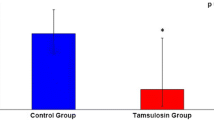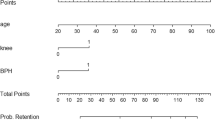Abstract
Introduction and hypothesis
Previous studies have found that administration of phenazopyridine decreased short-term urinary retention following surgery but other more recent trials have shown mixed results. This study sought to investigate the potential benefit of preoperative administration of oral phenazopyridine in relation to the prevention of short-term urinary retention following urogynecologic surgery.
Methods
This is a retrospective cohort study of a convenience sample of women undergoing urogynecologic surgery from June 2016 to March 2019. Following surgery, subjects underwent a standardized retrograde voiding trial. The data had previously been gathered from a prior prospective trial at our institution (Kesty et al. Int Urogynecol J 31(9):1899–1905, 11). Chart review was performed to determine whether patients that received 200 mg of preoperative oral phenazopyridine to better visualize ureteral efflux during cystourethroscopy were more or less likely to pass their postoperative voiding trial. Bivariate statistical analysis was performed as well as a multivariate logistic regression model.
Results
A total of 165 subjects were included in the final analysis; 100 who did not receive preoperative phenazopyridine and 65 who did receive phenazopyridine. There was no statistical difference between voiding trial pass rates following urogynecologic surgery between those who did not receive preoperative phenazopyridine compared to those who did [77% (77/100) and 82% (53/65), respectively, p = 0.37)]. The multivariate logistic regression model demonstrated no difference in postoperative voiding trial pass rates among those who received preoperative phenazopyridine compared to those who did not (OR 1.7, 95% CI: 0.53, 5.8).
Conclusions
Preoperative administration of oral phenazopyridine does not decrease short-term urinary retention following urogynecologic surgery.
Similar content being viewed by others
References
Wu JM, Matthews CA, Conover MM, Pate V, Jonsson Funk M. Lifetime risk of stress urinary incontinence or pelvic organ prolapse surgery. Obstet Gynecol. 2014;123(6):1201–6.
Shang E, Xiang B, Liu G, Xie S, Wei W, Lu J. Determination of phenazopyridine in human plasma via LC-MS and subsequent development of a pharmacokinetic model. Anal Bioanal Chem. 2005;382(1):216–22.
Propst K, Tunitsky-Bitton E, OʼSullivan DM, Steinberg AC, LaSala C. Phenazopyridine for evaluation of ureteral patency: a randomized controlled trial. Obstet Gynecol. 2016;128(2):348–55.
Dueñas-Garcia OF, Patterson D, De la Luz Nieto M, Leung K, Flynn MK. Voiding function after midurethral slings with and without local anesthetic: randomized controlled trial. Female Pelvic Med Reconstr Surg. 2017;23(1):56–60.
Dueñas-Garcia OF, Sierra T, Taylor D, Leung K, Hall CD, Flynn MK. The effect of oral phenazopyridine on perioperative voiding after midurethral slings (EPIPhANy study). Female Pelvic Med Reconstr Surg. 2018;24(2):95–9.
Sierra T, Taylor DL, Leung K, Hall CD, Flynn MK. The effect of Phenazopyridine on immediate postoperative voiding after prolapse surgery: a randomized controlled trial. Female Pelvic Med Reconstr Surg. 2019. https://doi.org/10.1097/SPV.0000000000000737.
Adelowo AO, Hacker MR, Merport Modest A, Elkadry EA. Do symptoms of voiding dysfunction predict urinary retention? Female Pelvic Med Reconstr Surg. 2012;18(6):344–7.
Alas A, Hidalgo R, Espaillat L, Devakumar H, Davila GW, Hurtado E. Does spinal anesthesia lead to postoperative urinary retention in same-day urogynecology surgery? A retrospective review. Int Urogynecol J. 2019;30(8):1283–9.
Pulvino JQ, Duecy EE, Buchsbaum GM, Flynn MK. Comparison of 2 techniques to predict voiding efficiency after inpatient urogynecologic surgery. J Urol. 2010;184(4):1408–12.
Geller EJ. Prevention and management of postoperative urinary retention after urogynecologic surgery. Int J Women's Health. 2014;6:829–38.
Kesty K, Edenfield A, Castro D, Medina L, Naser M, Manríquez V, et al. Subjective versus objective determination of bladder emptying following urogynecological surgery: "do you feel that you completely emptied your bladder?". Int Urogynecol J. 2020;31(9):1899–905.
Aguirre AG, Malik SA, Rzepka A. The use of alternative agents to indigo carmine during cystoscopic evaluation of ureteral patency. J Minim Invasive Gynecol. 2015;22(6S):S155.
Espaillat-Rijo L, Siff L, Alas AN, Chadi SA, Zimberg S, Vaish S, et al. Intraoperative cystoscopic evaluation of ureteral patency: a randomized controlled trial. Obstet Gynecol. 2016;128(6):1378–83.
Stitely ML, Harlow K, MacKenzie E. Oral riboflavin to assess ureteral patency during cystoscopy: a randomized clinical trial. Obstet Gynecol. 2019;133(2):301–7.
Grimes CL, Patankar S, Ryntz T, Philip N, Simpson K, Truong M, et al. Evaluating ureteral patency in the post-indigo carmine era: a randomized controlled trial. Am J Obstet Gynecol. 2017;217(5):601.e1–601.e10.
Luketic L, Murji A. Options to evaluate ureter patency at cystoscopy in a world without indigo carmine. J Minim Invasive Gynecol. 2016;23(6):878–85.
Doyle PJ, Lipetskaia L, Duecy E, Buchsbaum G, Wood RW. Sodium fluorescein use during intraoperative cystoscopy. Obstet Gynecol. 2015;125(3):548–50.
Mevcha A, Drake MJ. Etiology and management of urinary retention in women. Indian J Urol. 2010;26(2):230–5.
Author information
Authors and Affiliations
Corresponding author
Ethics declarations
Conflicts of interest
None.
Additional information
Publisher’s note
Springer Nature remains neutral with regard to jurisdictional claims in published maps and institutional affiliations.
Rights and permissions
About this article
Cite this article
McSwain, S., Woll, A., Edenfield, A. et al. The effect of preoperative phenazopyridine on short-term urinary retention following urogynecologic surgery. Int Urogynecol J 33, 711–715 (2022). https://doi.org/10.1007/s00192-021-04699-w
Received:
Accepted:
Published:
Issue Date:
DOI: https://doi.org/10.1007/s00192-021-04699-w




